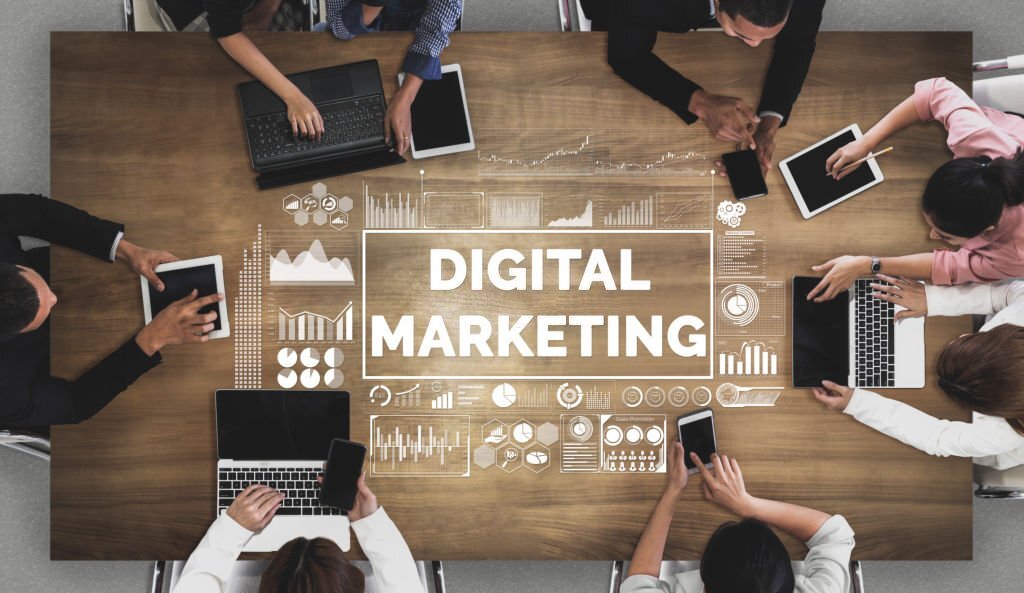In the world of digital marketing, time is of the essence. Your competitors aren’t going to wait up on you before they start trying to take the lead. Without digital marketing, your website will just sit there. Number 171 million with no one ever seeing your pages except the people you share a link with on social media or hand a business card to. If you were looking for ways to use digital growth marketing growth techniques to increase your business’s online presence, this page should be your last stop.
Grab a notepad and a pen, your favourite app, or something to jot down notes with on your desktop calendar because, in this post, we’re going to hand you all of the tools that it takes to grow a small business with very little revenue— into an online industry leader with substantial market share and sustainable success.
Read on.
What is Digital Marketing?
What is digital marketing? It seems like a no-brainer, but some people are confused about what it involves. Digital marketing refers to a very broad set of marketing techniques that you can use to grow an online business, affiliate blog, or other types of online entities into a well-known and strong online presence with high visibility, brand recognition, authority, credibility, substantial click share, and a reputation by researching the behaviours of internet users—and then using a combination of proven techniques to target them and bring them in to convert them into customers.
In short, digital marketing is the set of marketing techniques that it takes to build a successful brand in today’s digital world.
Now, let’s break digital marketing down into its different types and talk about each one.
Types of Digital Marketing:

As a growth marketing agency with a diverse range of skills in all aspects of marketing for companies online, we have had to implement all types of digital marketing strategies in order to help our clients grow their businesses. From organic and paid ad campaigns to email marketing, social media marketing, and content marketing, our experience has equipped us with every skill that you could use in the digital world to grow your business.
Growth marketing combines numerous types of digital marketing and sales to attract potential prospects to your business website or blog, and then tracks metrics and analyses behaviours to determine what’s working the best, test new techniques, and eventually refine the marketing strategy until it is a fine-tuned machine to generate sustainable growth.
Here are all of the different types of digital marketing outlined with descriptions of each:
Organic Search Engine Marketing (SEO)
Organic search engine marketing also referred to as SEO, is the process of implementing a set of techniques with the intent to improve the performance of your website and its pages and the content of your website so that they communicate better with search engines and with visitors. Organic search engine marketing, when done correctly, can drastically improve visibility online, increase traffic, and make your website communicate better with site visitors and search engine crawlers in a fairly short amount of time.
When mixed with content marketing, SEO can build relationships with your prospects, boost all of your most important metrics, and build trust and authority in your niche while giving you a competitive advantage over your competitors.
Paid Search Engine Marketing (SEM)
Search engine marketing, or SEM, refers to several different marketing models because the main objective and search engine marketing is to improve how easy it is to find your website on search engine results pages. SEM, although mostly used separate from SEO, is actually an umbrella term that covers SEO in both paid and unpaid advertising methods. Paid ads are the ads that you see every time you Google a search term at the very top of the search results and at the very bottom of the search results that are labelled with an “ad” or “sponsored” label beside them.
With paid search engine marketing, you pay to advertise on platforms like Google AdWords or Microsoft Advertising, after which your advertisements appear in those 2-3 ads and on other channels such as YouTube, Instagram, Facebook, and other websites in Google’s partner network that are relevant to your ad campaign.
Content Marketing
Content marketing, in short, is a strategic approach that focuses on creating and distributing content that your target audience will find valuable with the intent to drive action. Content marketing is also used to build authority, credibility, trust, and, essentially, your brand voice over time by publishing consistent content that people like to read and engage with.
Content marketing works best when combined with SEO to target keywords and phrases your target audience will use to search for solutions and answers and then make sure that they get their answer. But even then, it’s about making your content provable, easy to understand, engaging enough to make people want to read it, and inviting and memorable enough to bring them back to your site again, in the end, content marketing is about building relationships that align your results with your business goals.
Email Marketing
Email marketing is a powerful type of direct marketing that uses email to promote products and services to potential prospects. Email marketing has one of the highest ROIs when compared with other marketing types, with an average of $42 made for every dollar spent. The goal of email marketing is to share new products, updates, and sales with contacts on a subscriber list or, in some cases, through cold outreach.
Email marketing normally involves strategy, consent, segmentation, personalization, A/B testing, automation, and other methods that are used to define, refine, and strengthen campaigns that will not only drive sales but build long-lasting relationships for your brand.
Social Media Marketing
Social media marketing uses social media sites and strategies to build social networks and share information about your products and services. The goal of social media marketing is to build a company’s brand, brand voice, and community around the brand while increasing sales and driving website traffic to boost conversions.
Social media marketing also allows companies to take advantage of opportunities to learn from competitor strategies, build relationships with their prospects in real-time, and share their content on platforms that are already popular with millions of people. In most social media marketing campaigns, a marketing mix is used, whether 80/20 or 65/35; other content to company content is used, which is proven to work.
Additionally, key metrics (KPIs) are recorded, such as reads, likes, retweets, follows, unfollows, clicks, and hashtag performance, to determine what’s working the best to attract and engage prospects and which referral channels are performing best to help refine social media marketing campaigns and determine which platforms will get the best traction for the brand.
Influencer Marketing
Companies can use influencer marketing to market their products and services by collaborating with online influencers. Collaborations between brands and influencers are often less tangible and only looking to improve brand recognition through influencer marketing. Influencers can usually be distinguished by their large following and the fact that they don’t follow nearly as many people, but it’s also their activity and interactions with followers that make them influential.
Some influencers might have millions of followers, and some may only have five or 10,000, depending on the niche. There are tools out there that will help you find influencers in your niche, and it is not uncommon for companies to spend thousands of dollars on influencer marketing if they know they’re going to get a good return on investment from the influencer.
Referral Marketing
Referral marketing, also known as WOM, or word-of-mouth marketing, is a type of marketing in which customers are invited to share their experiences about the company’s product or services with their friends, families, and social circles in return for free products, money, or other incentives.
Referral marketing is powerful because of its influence. People naturally share their experiences with their friends and family when they like or dislike something, and an astounding 92% of people claim that they trust referrals from friends.
Affiliate Marketing
Affiliate marketing is a type of marketing that encourages affiliates to promote their product or services by offering them compensation for traffic, sign-ups, or sales. Affiliate marketing is forecast to reach $8.2B by the end of 2022 and $4.2B by the end of 2024.
An affiliate marketing program works by allowing affiliates to promote the company and its products or services using content creation on their blog or website, sharing social media content, or using other media types to share affiliate links, banners, and other advertising media.
By tracking the links that lead to conversions and checking internal analytics, an affiliate marketing program can determine how many leads convert into sales and compensate affiliates accordingly.
Video Marketing
A video marketing campaign is a method of marketing a business’s products or services through video production. Video marketing can be a very useful tool for businesses who use it correctly, with over 80% of video marketers claiming that they are happy with their return on investment on video marketing campaigns. This isn’t hard to believe, considering that video improves brand recognition by up to 54% on average and increases click-through rates by 65% on average.
To capture the attention of prospects and drive them back to your website, make use of video marketing channels such as YouTube, Instagram, Facebook, TikTok, and other high-traffic platforms. Video marketing can help companies raise brand awareness, engagement, and product awareness and convert a ton of unknowing prospects into interested customers with product demos, educational videos, how-to videos, live videos, brand videos, and customer testimonials.
PR Marketing
Public Relations (PR) marketing is a cost-effective way for businesses to raise their profile and drive brand awareness by building relationships with journalists, news-makers, employees, shareholders, customers, communities, business partners, forums, and other digital media platforms and sites to promote brand awareness and drive prospects back to their website.
It is about placing your brand in front of the right people at the right time so that you can reach your business goals. PR also refers to the practice of earning editorial coverage for your brand or product by creating newsworthy content. PR is not advertising or marketing as such, although it can be used in conjunction with these practices.
PR is more focused on the quality of the content used to attract attention than the volume of it. PR marketing is a longer-term marketing strategy that focuses on building relationships and getting your name out there as opposed to boosting sales numbers. It is great for marketing a product or service that isn’t yet available for purchase to a wider audience or for establishing your authority as an industry expert.
Viral Marketing
Viral marketing encourages people to share information about a product or service with their friends, family, and colleagues naturally. The goal of viral marketing is to create a “viral” effect, where the message spreads rapidly from person to person.
A recent example of viral marketing is the “Alexa Loses Her Voice” Campaign by Amazon
Mobile Marketing
Mobile marketing is a type of marketing that uses mobile devices such as cell phones and smartphones to promote products or services. Mobile marketing can be done through SMS messages, mobile websites, or applications.
Radio and Television Advertising
Radio and television advertising are both popular forms of advertising effective at reaching a large audience quickly. Radio advertising can be used to reach people who are driving in their cars, and television advertising can be used to reach people who are watching TV.
How to Use Digital Growth Marketing Techniques to Increase Your Business’s Online Presence
In growth marketing, you identify a group of people who could be interested in your product or service, and then you try to reach them in a way that is likely to interest them. This might involve using ads, posting about your product on social media, or reaching out to potential customers directly. Growth marketing is about finding new ways to reach potential customers and get them interested in what you offer.
Growth marketing is gradually increasing the number of people who know about and use your product or service. It involves tactics like PR, social media, and email marketing to get more people interested in your offer.
Here’s How to Use Digital Growth Marketing Techniques to Increase Your Business’s Online Presence:
Step 1 – Build User Personas
If you were putting a team together of all-star NFL players, do you know who you would choose for your team? Not a question, right? Well, you need to know who you are marketing to the same way that you are sure about your all-star team. That’s where user personas come in. Personas are imaginary people that represent your target players.
You create user personas by considering who your players are and what they like. What are their goals? What motivates them? How do they know about your brand? What do they think about your brand? What problems are they facing at home or work?
A persona is a character template that represents a user type. Personas are based on research and help designers create products that appeal to real people. For example, you might create a persona for a busy mom who wants to be able to keep track of her kids’ activities. Or a busy real estate broker is out showing houses until late in the evening and doesn’t have the time he’d like to spend on his business blog.
Step 2 – Set Goals
Setting goals for a marketing campaign is easy. First, you need to know your business’s strengths and weaknesses and what your customers want. Once you have an idea of what you want to achieve, you can start planning your marketing strategy.
One way to set goals for a marketing campaign is to think about what you want to achieve and then list specific goals to help you reach that outcome. For example, if you want to increase search engine traffic to your business website, you might set a goal to increase the number of visitors by 20% in the next three months. Or, if you want to sell more products, you might set a goal to increase sales by 25% in the next month.
Outline your goals first; then the steps you will take to get there. After that, it’s time to start thinking about your growth funnels.
Step 3 – Build Growth Funnels
A sales funnel is divided into three parts: top, middle, and bottom. That’s where the acronyms like “TOFU” for Top of Funnel, “MOFU” for Middle of Funnel, and “BOFU” for Bottom of Funny come from!
Attract: (Top of the Funnel) The top of the funnel represents new potential prospects. At this stage, your main goal is to get them acquainted with your business. Create helpful content and engage your potential prospects. Then, strike up conversations with them on social media platforms.
Types of content you would use in this stage would be lead magnets, welcome messages, newsletters, blogs, social media posts, paid media ads on Twitter, Linkedin, Adwords, Facebook, Quora, etc.
Engage: (Middle of the Funnel) The middle of the funnel is where you share content that you’ve created that matches the needs and interests of your leads. This lets them know that you are there to help them and want to help. The middle of the funnel is usually the point of extended engagement, where companies nurture leads, build relationships, and establish trust with their audiences.
Types of content you would create during the middle of the funnel are email marketing, retargeting, self-service content like FAQs, live chat, loyalty programs, etc.
Convert: (Bottom of the Funnel) The bottom of the funnel is where your prospects are making their final buying decisions.
Content marketing for each growth funnel phase is best, and always deliver content based on the needs and interests of your leads. Create a plan, write it down on a content calendar, and stick with it.
Step 4 – Create a Growth Plan for Each Level
At this point, you’ve figured out who your ideal prospects are and how you can communicate with them. Now it’s time to plan out actions that you will take at each level of the sales funnel to attract, engage, and delight your prospects so that you can get them to convert into sales!
Building your blog out is a great way to pull in prospects from all levels and guide, engage, and nurture them with valuable content. If you’ve already got your blog going, consider getting yourself a few guest blogs on high-traffic, relevant blogs. That will get many people acquainted with your brand, and the referral traffic is never bad.
Step 5 – Stick to the Plan
Once you plan which actions you will take to bring in new prospects to start building towards your goals, just stick with the plan and be consistent. Although content marketing can bring in traffic pretty quickly if you know how to research your target audience, your keywords, and the content already out there, it takes time to build anything great, so be patient and stick with the plan!
Step 6 – Record Metrics
When planning and executing a growth marketing campaign, tracking its progress and metrics is important. This will help you improve your return on investment (ROI) and ensure that the campaign has the desired effect. You can track several different metrics, depending on your goals and what’s important to you.
Some common metrics include: website traffic, conversions, leads generated, customer acquisition costs (CAC), and ROI. Tracking these key metrics will help you better determine whether or not the campaign is successful and make necessary adjustments along the way. It’s also important to compare your results against your original goals to gauge how close you reach them.
Many online resources can help if you’re unsure where to start.
Step 7 – Test, Compare and Revise
With any type of marketing, there are numerous ways to approach your end goal. What works for one company might not work for another, and what works today might not work tomorrow. This is why it’s important to test your campaigns, compare the results, and revise as needed.
One way to accomplish this is to utilize different channels to promote your product or service. For example, try out a few different ads on social media or send out a few different direct mailers. Compare the results and see which ones are more effective.
You can also test different messaging. Try out a few different headlines or descriptions in your ads. See which ones get more clicks or generate more leads. And be sure to test different offers as well. See which ones generate the most sales or conversions. Finally, you should also revise your campaigns based on your results.
Conclusion
‘Growth marketing uses data and analytics to identify user acquisition channels and optimize campaigns to drive sustainable user growth. In other words, growth marketing is all about figuring out how to get more users and then doing everything possible to keep them around.
Growth marketing is a much more efficient way to grow a business than traditional marketing. With traditional marketing, businesses spend a lot of time and money on campaigns that may or may not be effective. With growth marketing, businesses can use data and analytics to determine which campaigns are working and focus their efforts on those channels. This results in more targeted and effective campaigns, which leads to more users and, ultimately, greater profits.
Secondary keywords: digital marketing growth, growth marketing vs. digital marketing, digital growth marketing, digital marketing agency growth, digital marketing business growth, digital marketing for business growth



